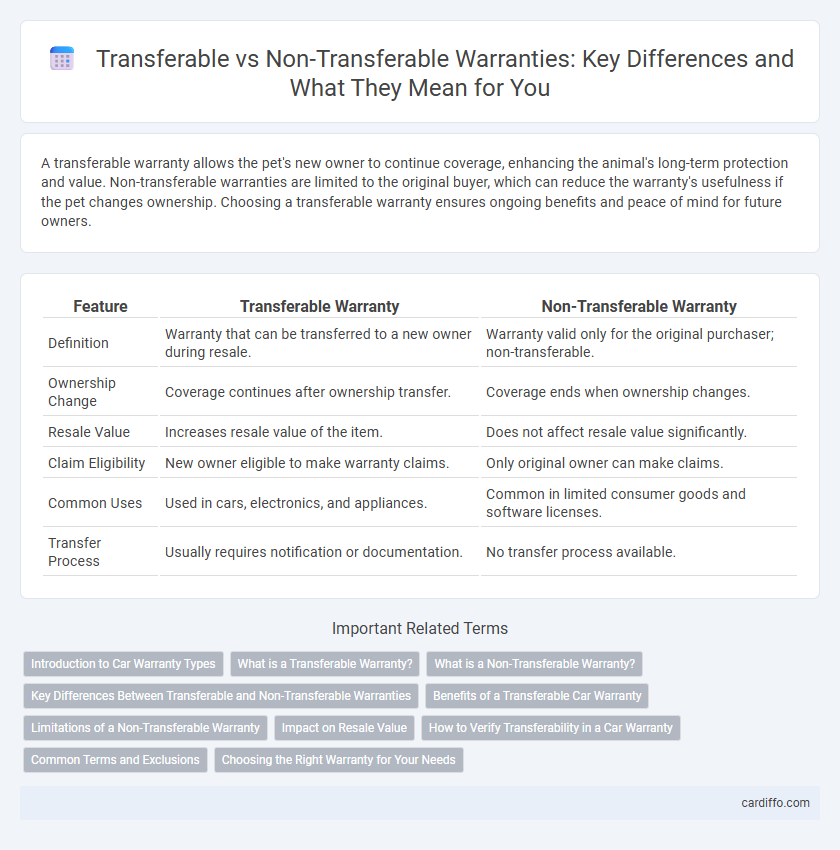A transferable warranty allows the pet's new owner to continue coverage, enhancing the animal's long-term protection and value. Non-transferable warranties are limited to the original buyer, which can reduce the warranty's usefulness if the pet changes ownership. Choosing a transferable warranty ensures ongoing benefits and peace of mind for future owners.
Table of Comparison
| Feature | Transferable Warranty | Non-Transferable Warranty |
|---|---|---|
| Definition | Warranty that can be transferred to a new owner during resale. | Warranty valid only for the original purchaser; non-transferable. |
| Ownership Change | Coverage continues after ownership transfer. | Coverage ends when ownership changes. |
| Resale Value | Increases resale value of the item. | Does not affect resale value significantly. |
| Claim Eligibility | New owner eligible to make warranty claims. | Only original owner can make claims. |
| Common Uses | Used in cars, electronics, and appliances. | Common in limited consumer goods and software licenses. |
| Transfer Process | Usually requires notification or documentation. | No transfer process available. |
Introduction to Car Warranty Types
Car warranties generally fall into two categories: transferable and non-transferable warranties. A transferable warranty allows the coverage to continue when the vehicle changes ownership, enhancing resale value and providing peace of mind to the new buyer. In contrast, a non-transferable warranty ends with the original owner, limiting protection and potentially decreasing the vehicle's market appeal.
What is a Transferable Warranty?
A transferable warranty allows the original owner to pass warranty coverage to subsequent owners, enhancing the item's resale value and providing ongoing protection. This type of warranty typically covers repairs or replacements for a specified period, regardless of ownership changes. Non-transferable warranties restrict coverage exclusively to the initial purchaser, limiting benefits once the product is sold or gifted.
What is a Non-Transferable Warranty?
A non-transferable warranty is a type of warranty that applies exclusively to the original purchaser and cannot be passed on to subsequent owners of the product. This restriction means if the product is sold or given away, the new owner will not benefit from the warranty coverage. Manufacturers often use non-transferable warranties to limit their liability and encourage consumers to purchase directly from authorized sellers.
Key Differences Between Transferable and Non-Transferable Warranties
Transferable warranties allow the warranty coverage to extend from the original purchaser to subsequent owners, enhancing the product's resale value and buyer confidence. Non-transferable warranties are strictly limited to the original buyer, which restricts coverage and can decrease the product's appeal in secondary markets. Key differences also include varying coverage duration and claim eligibility, with transferable warranties often providing longer protection periods.
Benefits of a Transferable Car Warranty
A transferable car warranty enhances the vehicle's resale value by providing future owners with continued protection against unexpected repair costs. This type of warranty offers peace of mind to buyers, increasing marketability and demand for the car. Transferable warranties also simplify ownership transitions and reduce concerns related to coverage lapses.
Limitations of a Non-Transferable Warranty
Non-transferable warranties restrict coverage solely to the original purchaser, preventing subsequent owners from claiming repairs or replacements. This limitation significantly reduces the product's resale value and appeal due to the absence of assured protection for new buyers. Manufacturers may also decline service requests once ownership changes, creating potential financial risks for secondary purchasers.
Impact on Resale Value
Transferable warranties significantly enhance resale value by providing buyers with ongoing protection, increasing buyer confidence and marketability of the product. Non-transferable warranties limit this benefit, often lowering the perceived value since coverage remains only with the original owner. As a result, products with transferable warranties typically command higher prices and faster sales in secondary markets.
How to Verify Transferability in a Car Warranty
To verify the transferability of a car warranty, check the warranty documentation or contact the manufacturer or dealership directly to confirm policy terms. Many transferable warranties require the new owner to notify the manufacturer within a specific period after the vehicle changes hands. Reviewing the warranty's fine print ensures clarity on conditions, fees, or restrictions related to transferring coverage.
Common Terms and Exclusions
A transferable warranty allows the original owner to extend coverage to subsequent owners, often requiring a formal registration process for validity, while a non-transferable warranty limits coverage strictly to the original purchaser. Common terms in both warranties include specified coverage periods, repair or replacement of defective parts, and adherence to proper maintenance. Exclusions typically involve damage due to misuse, unauthorized repairs, normal wear and tear, and cosmetic defects.
Choosing the Right Warranty for Your Needs
Choosing the right warranty involves understanding the benefits of transferable versus non-transferable warranties, where transferable options provide coverage that extends to subsequent owners, enhancing the product's resale value. Non-transferable warranties limit protection to the original purchaser, often resulting in reduced appeal for future buyers but may offer lower initial costs. Assessing factors such as ownership duration, resale plans, and coverage specifics ensures alignment with your long-term needs and investment security.
Transferable Warranty vs Non-Transferable Warranty Infographic

 cardiffo.com
cardiffo.com